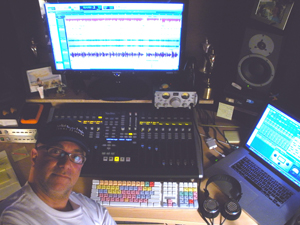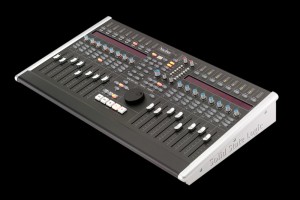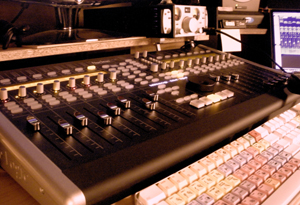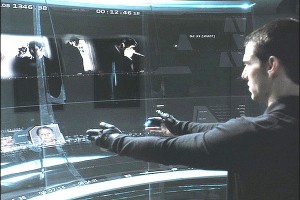REVIEW: SSL Nucleus by George Walker Petit
Why I Need One/Reason for Purchase
As an independent engineer/producer for over 25 years, I’ve been somewhat reticent to outfit and install a “home” or “project” studio. The majority of my work has taken place in major commercial studios, only occasionally moving to a smaller mix or editing suite if forced by budgetary constraints – or that “overkill” concept when using too much real estate.
These major rooms usually boast a large format console (SSL, Neve, API) with the de rigueur racks of outboard, professional room design and layout choices that (hopefully) make an engineer’s workflow efficient.
When digital audio first reared its head, the “home” or “project” studio had a somewhat negative connotation. “Oh, you have a project studio. Hmmm…how lovely for you!”. Visions of ¼” patchbays with wires hanging out of the back, a home-made, plywood “rack”, the screws barely holding four ADATs.
OK, sorry, maybe your home studio was not that bad. But most were sub-par installations in little more than a spare closet with neither adequate acoustic treatment nor quality signal processing — front end or back end. In most cases, granted, these were “labs”, places where one honed one’s skills, but hardly studios that were capable of producing a finished product of quality. Years back you needed a bigger budget and more space in order to build anything respectable. The gear was still huge and expensive and the thinking was somewhat archaic.
But as the technology has raced to meet the qualitative demands of professionals needing to service clients with ever-decreasing budgets, I have been forced to re-assess my position, to sit up and take notice. These days, I feel it’s essential that working engineers, producers and perhaps even serious songwriters have access to a professional system at all times.
More and more the music has become married to the tech (no comment on that here), and with the advances resulting from years of technical innovation and competition, I further believe that we all can in fact have such access. If well thought out, such a studio can produce work sonically competitive with that of the commercial studio.
We’ll always need big live rooms and iso’s, budget willing, but to arrange, edit and mix “at home”, at a high level is more than just possible now. I still track at major studios, but I would say that a good 60% or more of my work these days happens in my “home” studio. Which sounds fantastic, by the way. I love it.
My latest upgrade has been the SSL Nucleus, a small format console aimed at a really good smaller professional studio — or what we used to in fact call the “project” or “home” studio. The Nucleus is meant to act as the nerve center of a modern digital studio, a communications hub, a liaison with your DAW. In fact, with a few of your DAWS.
But before you read further, let me make a bit of a disclaimer here: During my rather exhaustive research before purchase, I looked at myriad websites quoting the specs, the numbers, the technical comparisons and measurements. I needed to know those things and they are all rather impressive, and I urge you to get out there on the Web and do the same research. But you won’t find them here in my review, since it’s already been done.
Instead, I prefer to talk about my reactions and observations in terms of how the Nucleus affects my work, how it makes me feel about my work and my efficiency. The numbers inform my decisions, certainly. But they do not dictate my decisions.
If a piece of gear sounds great, enhances my workflow and adds value to my final product I usually buy it. If, above that, the gear removes encumbrances to the creative connection between me and the music, I certainly buy it.
I bought the SSL Nucleus. I have had it installed for a little under three weeks. Here are my observations…
No Second Chance to Make a First Impression
The fact that Nucleus is an SSL cannot be ignored. This brand recognition and reputation certainly impacts one’s decision to buy. If it says “Ducati” on the gas tank, it had better respond like a Ducati. If it is from “SSL”, I expect — 100 percent — that the chaps over there in Oxfordshire understand this client perception and would naturally not want to release any new piece of gear that doesn’t measure up. The release of such a piece of gear would be disappointing, would impact client base and would be…downright foolish, right?
They are not fools in Oxfordshire, I am still an SSL fan and the Nucleus does not disappoint.
From Moment One, opening the box upon its arrival, I was impressed. The Nucleus is well presented and packed for safety. It comes with very little documentation, and it needs very little. The unit is heavy, sturdy, doesn’t feel “hollow” and plastic, and in fact it gives the impression of solidity and a high build quality. An SSL through and through. One touch of the transport section or one move of a fader and you just know it’s a professional piece of gear. “Now we’re talking…” was, as I recall, my first thought.
Visually, it’s a treat. Bold lettering, and apparent pride in design and build. Beginning with the start-up LED’s and the back-lit “Solid State Logic” the layout looks smart, is ergonomically functional and is immediately intuitive. There is more than adequate room between knobs and buttons for my fat fingers. The rear panel is clear, clean and equally solid, obviously well thought out. I’d say the overall “look” is inviting, from the 16 smooth and precise faders to the uncluttered, functional layout of controls. One instantly wants to engage with the Nucleus, to get down to some meaningful work.
Nucleus has a larger footprint than my old Avid 003 controller, but there is truly no comparison in design, build quality and intuitive layout. Different world. Nucleus makes me smile. If you’ve spent time with an E, G, K, J or Duality over the years, you’re going to feel right at home here.
My old Avid sat to the right of center on my workspace for the few years I had it. I used it sporadically, didn’t reach for it all the time. For many reasons, I did not want it as a studio “centerpiece”. There wasn’t the immediate connection that the Nucleus makes. My new Nucleus is centered in my workspace, in my studio, and I feel like I am back on a quality console, not a plastic controller. Even before I installed and configured, I truly felt that it was going to bring up my game.
Installation
Installation and connectivity was a cinch. The Nucleus connects to your computer via USB interface and with your DAW via Ethernet. After installation of drivers and other needed software, connection of these two cables and power (standard IEC), I was up and running.
Before connecting my monitors, I plugged-in a pair of Grado headphones and began to configure the software, having attached my iPod through the “ijack” (1/8th miniplug input on the rear panel) to listen to some tunes while working. At this stage, I was introduced to the Nucleus Remote, the nerve center of the Nucleus software, and the USB Control Panel, where users configure the sound card, again all very straight-forward and fast. The users manual is completely clear, short and sweet, and gets you through the process without headache.
You can configure just about anything you can think of with the Remote: templates, “profiles” (their word), soft keys, functionality of the jog wheel, master transport control, preferred DAW.
A wonderful option to note here is that one can work with multiple DAW’s with any of three operating at the same time, a chosen one being the master. This switching/multiple DAW capability is a thing of beauty, and it is seamless. I tried it with Pro Tools and Logic for a bit to test it…perfect. Again, the manual is there if you need it, but the machine’s operation is so clear and logically presented that I was through the entire process and monitoring audio in no time. In fact from opening the box to operational status was just shy of one hour.
I should mention that the only possible “issue” here is that when Nucleus is connected to your computer with the Ethernet cable, and once the network is configured, one can not use the Internet simultaneously. Some might consider that a big issue. I know I do — a big POSITIVE issue! I am no longer interrupted in my workflow by emails and the temptation to play on the Internet.
Operation
Now, I have certain peculiarities in my workflow as, I am confident, most of us have! Some projects work with templates including settings and chosen go-to plugins. Some work solely in 44.1 and 48 or, “Sorry, I only work in 96 and higher”…whatever.
I am pleased to report that the ability to custom configure your Nucleus is staggering. It is obvious that SSL want you to make the Nucleus the hub of your studio – even in some cases programming the soft keys to deliver keystroke commands normally covered by your QWERTY keyboard. Yes, you can do that: One machine as the control center for basically EVERYTHING. Get creative, and pretty much any function you need to control can be designed and assigned, then “played” on the Nucleus, and then saved to an SD card. You “play” the Nucleus. Ever see Minority Report with Tom Cruise? That’s the feeling I get.
I set up a quick user profile under my name with a session template and my go-to plugs, then opened a previous session of a multitrack project with some 38 channels of acoustic instruments recorded live by me at MSR Studios in NYC, with a tad+ of MIDI and overdubs, tidied up for a few minutes to impose order on the session and started mixing. Then I saved the profile, saved the session, shut down and started up again…and gee, gosh, golly, it works! You can get quite deep with configuration, and I intend to do so as time goes on fully buying into SSL’s intention for us here.
I should say that this ability to customize draws me deeper into SSL’s cunning plan, invites me further into the game, and I am really loving that. I am not frustrated by a learning curve here, as one perhaps can be on a new OS. rather, I am anxious to get deeper to improve my workflow and product. SSL’s clear, logical presentation and protocol actually invites me to peel back more layers. The deeper you get, the better you work.
And nothing gets in the way. Unencumbered, creative engineering. What a concept.
You’ll get the same feedback and solid feeling with the V-pots, V-sel switches, faders, everything functions as expected and screams: “Quality”. Automation, plugin control, panning (continuous pots, by the way), assignments, monitoring and gain structure, any normal functions and processes associated with a session are intuitive, easily accessible and serve to improve one’s job. The “conduit” between the engineer and the music has had a pipe cleaner run through it – all cleared up now, thank you very much.
Sound
Does a “controller” have “a sound”? First let me say that I don’t consider Nucleus a controller, I consider it a small format console. This niche market for an “in-the-box” control solution has many contenders, to be sure. And they all pretty much do the same things, some more than others. But to me, it’s how they do what they do, to what depth and with what level of sonic integrity, how effective are they? I think Nucleus deserves to be called a console.
SSL has included a pair of their SuperAnalogue mic pre’s in the Nucleus, basically the same ones from the Duality. The pre’s deliver a true SSL sound, folks. The lo’s are rich and focused, mid’s are uncluttered and well-defined, while not overbearing and the hi’s are transparent with a lovely “shimmer” up there…sans ice-pick! Plenty of punch or smoothness, depending on what you’re doing with it. This pair of pre’s are far above the quality of the competition, and not even worth comparing to my old “controller”. To have them included on the Nucleus is a gift.
Now, I am not using the Nucleus to track a live band in a live room, so I really don’t need talk-back or multiple cue mixes. If you’re going to use Nucleus to that end, I’d suggest you also purchase the right gear to fill those needs, I don’t need it, so the fact the Nucleus doesn’t have it doesn’t bother me. I’ve read a few complaints about this, but I don’t consider it a deal breaker. Perhaps SSL will alter this situation in the future, perhaps not. Nucleus is not “all things to all people”, and it’s not meant to be.
But I do monitor on speakers and headphones, and…surprise! The analogue monitor section is fantastic-sounding, worlds better than my old Avid, yet again. There is a lot to be said for more headroom, a better sound card, increased clarity, right? SSL has addressed these issues and clearly beat the competition again. Quality AD/DA conversion and analogue outputs. Bullseye.
I will be using the Nucleus extensively to edit work tracked in large live rooms, do a number of overdubs and then fully mix projects ranging from jazz to acoustic music to rock, and the occasional film score. Fact is, I will use the Nucleus for just about everything I do, except track full bands. I have little doubt that it will continue to impress and deliver. Let me go one step further: Aside from working for my paying clients on it here in my studio, I have decided that I will record and mix my next project of MY music on it here as well – I really don’t see any limitations.
Sonically, the Nucleus beats what I used to run by leaps and bounds. This creates something to me that is a game changer. If you take that sonic integrity into account along with the intuitive functionality of the desk, its ergonomic, “sexy” design and the ability to customize its interface, what you end up with is a tool that gets you closer to the music. I know I keep saying it, but I really want you to hear that. Nucleus helps me make my work sound better. Period.
Conclusion
Obviously, I’m a fan. Over 25 years of working on many consoles including SSL’s of all shapes and sizes, I am not in the least bit surprised that the lovely folks from Solid State Logic have brought us a small format console of this quality, probably the best in this market. The Nucleus measures up to the rest of the SSL line – you will get what you expect from an SSL.
From functionality to build quality, support and sonic footprint, Nucleus raises the bar and slays the competition. I really have nothing bad to say about it that is of any weight at all. I’d love another pair of XLR monitor outs for my second pair of speakers, but I won’t cry, I’ll probably buy the SPL 2-Channel next week. Game over.
Add to this the included Duende package and you have a real game-changer here. Let me restate the obvious: Other plugin designers “model” SSL EQ and dynamics – and there are some really great sounding emulations out there. I have a few. But they always sound “just like an SSL”. Hear me? Duende doesn’t sound like SSL, it is SSL. It’s made by the same guys that made the originals and inasmuch, these plugins have a richness and sound that is truly SSL, not a knock off.
I researched and got into this whole Nucleus thing looking for improvements to my studio and my work for clients. I wanted to get my product better, increase efficiency through a more focused workflow and become re-inspired by my equipment. Nucleus has surpassed ALL my expectations. Fantastic piece of gear, best purchase I have made in years.
The MSRP is $4999.00: Is it worth this hefty price tag? Absolutely. Yes, perhaps it is “hefty” if one thinks in terms of a “home” studio in the old sense. I don’t. The Nucleus takes me out of that thought pattern.
Cheers!
gwp
George Walker Petit thinks a lot about mixing and many other musical things. An award-winning producer and mixer, he is based in New York City. Visit George at his Website, and keep up with him and the Drew Zingg Debut Album Project here.












Phil
May 30, 2011 at 5:54 am (13 years ago)Great review George! I was thinking about the Roland SONAR-V Studio 7 Console until I saw your review on the Nucleus. I just jope it plays nicely with my Fireface 800.
Fish
September 19, 2012 at 11:18 am (12 years ago)Thx very much george! I readed and viewed alot before for my lil new session studio. As i saw that console, looked the first video and now your great review and ideas….i felt in love. Im happy and now shure to spend my hard worked money in nucleus by ssl. Thx very much for this.
Vibey from Fish
StanTheManFromEastCunningham
November 15, 2014 at 10:57 pm (10 years ago)Super Review GWP!!!!